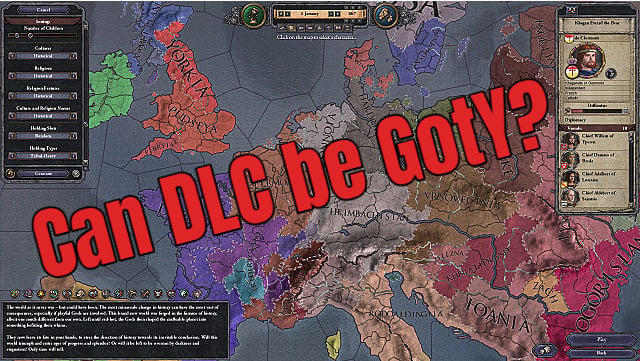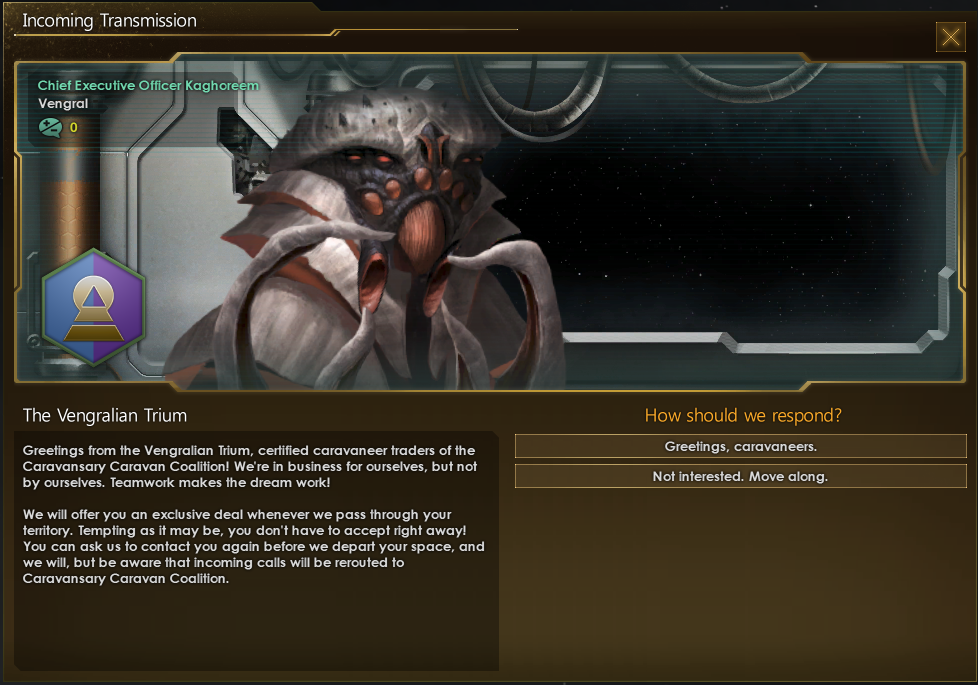The debate over game of the year invariably involves big, AAA titles with lots of advertisement hype and Hollywood-like gross revenue numbers.
But what if I told you that my top three games of 2018 are two DLC packs and a free patch?
Specifically, they are the Holy Fury DLC for Crusader Kings II, the Industries DLC for Cities: Skylines, and the 2.2 “LeGuin” patch for Stellaris.
In choosing DLC for a game of the year vote, I feel like I should lay out some ground rules so that anyone reading this knows how to make expansion content the very best it can be.
For any developers out there, follow these simple rules and you’ll have all the Frys on the internet yelling, “Shut up and take my money.”

Rule 1: Breathe Fresh Life Into An Old Game
Holy Fury‘s biggest virtue is that it adds the Shattered and Random Worlds that were always missing from Paradox’s various strategy series. When you stir up the starting parameters of the game, you take a series that was constrained by history and turn it into a lively, never-the-same-game-twice experience that almost equates to grand strategy mixed with roguelike.
Likewise, Industries fixed one of Skylines’ few weaknesses; in the base game, industrial zones are almost useless once the bulk of your citizens begin working in office buildings because offices produce higher tax rates for lower crime and no pollution.
With Industries, industrial production becomes a game all its own, and the way the systems work together create a meta game that stays fun and useful well into the massive metropolis late-game.
And finally, “LeGuin” so completely revamps the way planets work in Stellaris that every strategy you had from pre-2.2 versions of the game are rendered instantly obsolete.
When a free patch does more to revolutionize gameplay than some games see with an entire suite of paid DLC, that is a massive achievement that feels like a Christmas present from the developers.

Rule 2: Provide Something For Everyone
The second rule of great DLC is to avoid couching content behind a playstyle barrier; in other words, create a DLC that’s flexible, not one that alienates players that don’t adhere to a specific playstyle.
While most of the main gameplay in Holy Fury is skewed toward pagan rulers, giving them buffs to keep up with every other religion post The Old Gods, all the value here comes back once again to Shattered Worlds.
A lot of the fun in CK2 is in turning very small counties into massive empires. For a lot of players, it’s simply not much fun to start as a vassal. You spend the whole early-game waiting for events beyond your control to happen so you can declare independence. But at the same time, if you start as a king, the game’s often too easy with what little challenge there is coming in preventing or putting down revolts when you have the resource and army advantage.
Even if you disagree with that assessment of vassals and kings, Shattered Worlds still has something for you. The mere fact that you can break up the world any way you like (from a world with naught but one-province minors to one with completely unique kingdoms and empires) means it’s never the same world twice.
No matter your playstyle, there’s something in the DLC for you.
Industries is the same way in Skylines. You’ll get the most out of it when you’re building industrial cities, of course. But even if all you use it for quick jobs while you’re waiting for offices to unlock, you’re still covered.
Put simply, the new system is more fun and makes more sense than the old system in every single situation where industrial zones are involved. Every playstyle uses industries at some point during the game, so every playstyle benefits from a better system.
And LeGuin… well, you’re getting those new systems unless you want to rollback to 2.1 and stay there. Every playstyle’s using it whether they want to or not. It’s a patch.
Rule 3: Don’t Gouge. Keep Your Prices Reasonable
Holy Fury costs $20 and delivers a full game’s worth of fresh content updates at that price. Industries costs $15 and fundamentally changes the game’s economy for the better, changing the whole way you’ll play Skylines no matter your playstyle. And the 2.2 patch for Stellaris is free; you don’t even have to buy the MegaCorp DLC that it launched alongside.
Roughly half what the base game costs are a fair price for a DLC pack. Value for investment is an important component in evaluating the very best games, after all.
—
Yes, DLC can be game of the year.
When you breathe life into an aging game, eat up a game writer’s entire week to the point where he almost misses deadline getting the guide out because he couldn’t drag himself away from the game for three hours to write it, and offer something for everyone?
Nothing else in gaming offered me that in 2018. Holy Fury gets the gold medal, Industries gets the silver, and a free patch for Stellaris gets the bronze.
It’s a shame more people didn’t consider these for gaming’s highest honor.








Published: Dec 20, 2018 04:45 pm